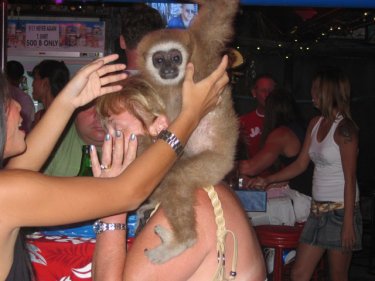Many people wanted to hold her and feel her soft, fluffy fur and the strong grip of her hands as she clung on to their shirts instinctively, in the same way as she would have clung to her mother when shot down from the trees in their rainforest home a few months earlier.
Money changed hands quickly as Cop's handler moved her swiftly around the bars, never staying too long with any one tourist at a time. This baby gibbon was not the only one of its kind in Patong this year.
In 2004, the year leading up to the disastrous tsunami, at least a handful of baby gibbons were used as photo props in Phuket's tourist areas.
Luckily for some of them, they were eventually confiscated and handed over to the Gibbon Rehabilitation Project, were they have been given a second chance in life.
Wild gibbon numbers in Thailand may have dropped by up to 80 percent in just over30 years, mainly due to the illegal trade for the tourist industry.
Since 2002 GRP has managed where many other projects in the past have failed to reintroduce some of these traumatised, captive raised, orphaned primates back into the wild.
Today there is a small, breeding, population of gibbons again in Phuket's last sizable rainforest, Khao Phraw Thaew. When the last wild gibbon was killed here in the early 80s this forest became silent, but today the calls of wild gibbons can be heard again from the lush canopy.
Eight gibbon families have been released into the wild by GRP through a labor intensive method in which the animals are gradually allowed to adjust to their new environment.
The project staff continues to carry up hundreds of kilograms of food into the forest until the gibbons' wild foraging skills are sufficiently developed. Before being able to return to the way of living nature intended for them, these humanised gibbons have a lot to learn.
Unfortunately not all gibbons that arrive at the Phuket centre will get this chance to return to the wild. Many gibbons arrive with physical injuries of human abuse, or diseases that they have caught from living in close proximity with man.
Being apes like us, gibbons can catch and spread anything from herpes to HIV and tuberculosis. Only physically and psychologically healthy individuals are selected for the reintroduction program.
Cop was just one of a number of baby gibbons rescued from Patong in 2004 and she was named by the policeman who brought her in.
Cop's story is one of hope, as she is now about to complete the circle and return to the wild with her partner and little son.
These past eight years have been a steep learning curve for her, but this is how long the rehabilitation process often is. The family's release is planned for October this year.
A few years back Cop and her partner were successfully paired up at GRP's rehabilitation site and they have now raised their first-born through infancy.
Cop is a good mother and her attachment to humans has declined during her rehabilitation, both of which are good signs that she may adapt well to a life in the wild.
It is hoped that once her son is all grown up in eight years or so, he may find a partner of his own from among the growing reintroduced gibbon population in this forest.
Thanks to the extensive education work carried out by the Phuket rehabilitastion centre this forest is a relatively safe place for native gibbons to live.
However, to avoid a repetition of the vicious circle of wildlife trade in the future, it is important to educate tourists and cease the demand for endangered wildlife used as tourist photo props.
Visitors are welcome to The Phuket education centre and rehabilitation site, where some of the gibbons that cannot be released can be viewed. We are located at Bang Pae Waterfall, nine kilometres east of the Heroines Monument.
All sightings of illegal wildlife used as photo props may be reported to the Gibbon project team or directly to the DNP at: http://www.dnp.go.th/complain/index.asp
Petra Osterberg is a long term returning volunteer at the Phuket centre and a primatologist by profession. Gibbons were commonly kept as tourist attractions on Phuket in the past, in the same way as we see the slow lorises in Patong today. We still get reports of photo-prop gibbons from around Phuket, Krabi and Phang Nga. Wild gibbon numbers in Thailand may have dropped by up to 80 percent in just 30 years (or one gibbon generation). The Phuket centre has been rescuing and rehabilitating gibbons for 20 years now and during the past 10 years has successfully managed to re-establish a small wild breeding population of gibbons in Khao Phraw Thaew forest - the last sizable rainforest on Phuket.









Thanks Petra for an excellent and very interesting article!
Posted by Hepphepp on September 10, 2012 11:31